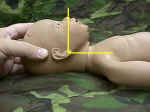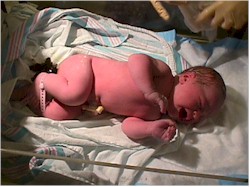Position the Baby
Babies should be kept on their backs or tilted to the side, but not
on their stomachs.
The orientation of the head relative to the body is important for
breathing. In adults, this orientation is not usually crucial; adults
tolerate a relatively wide range of head positioning without
compromising their airway. Not so with newborns who have a relatively
narrow range of head positioning that will permit air to move
unimpeded through the trachea.
The optimal position for the baby is with the head neither markedly
flexed against the chest, nor extended with the chin up in the air.
Instead, the head should be in a "military" attitude, looking straight
up.
Position the baby on its' back with the head looking straight up.
This will usually provide for good airflow.
If there is any airway obstruction, make small adjustments to the
head position to try to straighten the trachea and eliminate the
obstruction.
Evaluate the Baby
Evaluate the baby for breathing, color and heart rate. If the baby
is not breathing well or is depressed, additional drying with a towel
may provide enough tactile stimulation to cause the baby to gasp and
recover.
Babies are not slapped on their buttocks for this purpose, although
flicking the soles of the feet with a thumb and forefinger can provide
enough noxious stimulation.
Suction the Airway
When babies are born, they need to clear the mucous
and amniotic fluid from their lungs. Several natural mechanisms help
with this:
-
As the fetal chest passes through the birth canal it
is compressed, squeezing excess fluid out of the lungs prior to the
baby taking its' first breath. This is noticed most often after the
fetal head is delivered but prior to delivery of the shoulders.
After several seconds in this "partly delivered" position, fluid can
be seen streaming out of the baby's nose and mouth.
-
After birth, babies cough, sputter and sneeze,
mobilizing additional fluid that may be in their lungs.
-
After birth, babies cry loudly and repeatedly,
clearing fluid and opening air sacs in the process. Crying is a
reassuring event and does not indicate distress.
-
Newborn grunting actions may further mobilize fluid,
in addition to opening the air sacs in the lungs.
While babies will, for the most part, bring the
amniotic fluid out of the lungs on their own, they may need some
assistance in clearing their airway of the mobilized fluid. This will
require suctioning.
Bulb syringes are commonly used for this purpose,
suctioning both the nose and mouth of the baby. If a bulb syringe is
not available, any suction type device may be used, including a
hypodermic syringe without the needle.
If no suction device is available, keep the baby in a
slight Trendelenburg position (head slightly lower than the feet) and
turn the baby to its' side to allow the fluids to drain out by
gravity.


